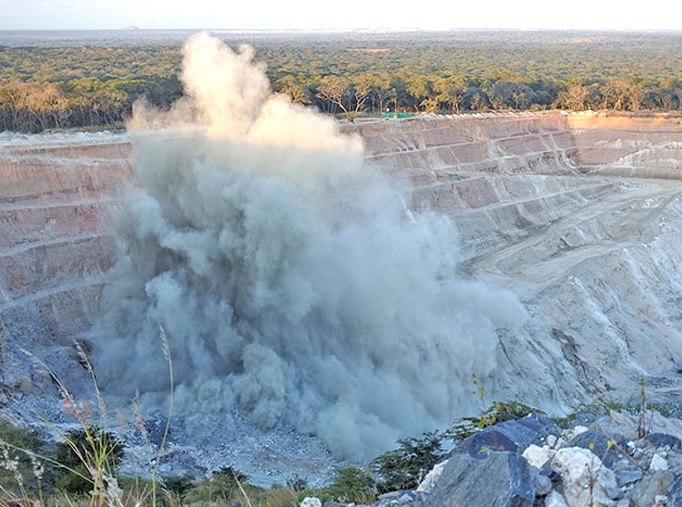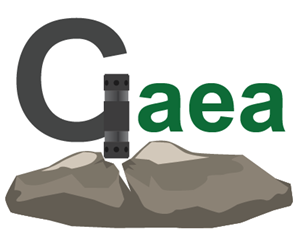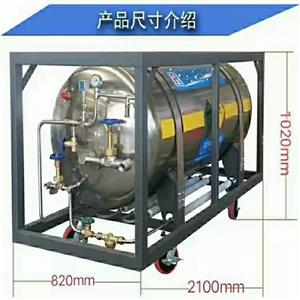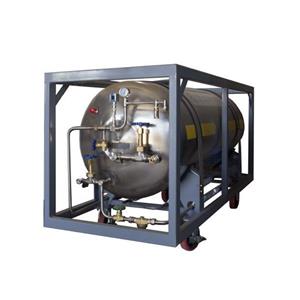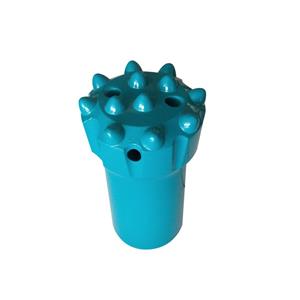Safety operating procedures for blasting operations in open-pit mines
1. General regulations for blasting operations
1. Blasting operations must strictly follow the relevant provisions of the "Blasting Safety Regulations" and the "Civil Explosives Safety Management Regulations".
2. Before blasting starts, go to the local public security agency with relevant procedures to handle the blasting construction approval procedures. Only after obtaining the blasting permit from the public security agency can you get the explosives to start work.
3. Blasting operators must undergo special technical and safety training, pass the examination of the public security department, and hold the "Blasting Safety Operation Certificate" before they can go to work.
4. Before work, you must wear a safety helmet, work clothes and work shoes. It is strictly forbidden to wear shoes with iron spikes, chemical fiber clothes that are prone to static electricity, and drink before work.
5. For deep hole blasting, chamber blasting, demolition blasting and controlled blasting, the blasting engineer shall prepare the "Blasting Design Plan", "Blasting Design Instructions" and "Blasting Construction Organization Plan" in accordance with the corresponding level and scope of work specified in the "Safety Operation Certificate". After review by the company's chief engineer, it shall be submitted to the relevant departments for approval or safety assessment before blasting construction.
6. For deep hole blasting in mining or engineering rock and soil, before the blasting operation, each blasting area shall issue the "Blasting Operation Instructions" in accordance with the blasting safety technology determined in the "Blasting Design Plan", and do a good job in the division of labor and technical guidance.
7. Blasting operations must be carried out strictly in accordance with the requirements of the "Blasting Operation Instructions", obey the command of the person in charge of the blasting operation site and the blasting engineering technicians, and accept the supervision of the safety officer.
8. If the blasting operation encounters a situation that is inconsistent with the "Blasting Operation Instructions" or there is a serious threat to safe operation, it should be reported to the blasting engineering technicians and relevant leaders, and the blasting engineering technicians shall make a modification to the blasting plan before the operation can be carried out.
9. During the charging operation, it is strictly forbidden to carry matches, lighters and other ignitable items, and it is strictly forbidden to smoke in the workplace.
10. Blasting operations are strictly prohibited in any of the following circumstances:
10.1. Blasting operations are strictly prohibited if the explosives are expired or deteriorated;
10.2. Blasting operations are strictly prohibited if there is no detonator code or it is overdue;
10.3. Blasting operations are strictly prohibited if the nature of the explosives is unknown;
10.4. Blasting operations are strictly prohibited if non-water-resistant explosives are loaded in water holes;
10.5. Blasting operations are strictly prohibited if control measures are not taken for blastholes with special geological structures or large terrain changes;
10.6. Blasting operations are strictly prohibited if controlled blasting technology is not adopted in a complex safety environment;
10.7. Blasting operations are strictly prohibited if communication is not carried out before detonation between two adjacent mines;
10.8. There is a risk of collapse or landslide.
10.9. Blasting operations are strictly prohibited in heavy fog, strong winds above level 6, heavy rain or thunderstorms.
10.10. Blasting operations are prohibited in mines where mining licenses have expired, mining has been conducted beyond the boundary, or the superior competent department has ordered the mines to stop production for rectification.
II. Safety operation procedures for blasting operations
(I) Drilling and hole inspection
1. Drilling
(1) Before drilling, the surface of the blasting area and the edge of the cliff must be cleaned, the safety environment of the blasting area must be inspected, the blasting method must be determined, and the drilling design must be carried out before the holes can be arranged.
(2) The holes should be arranged to avoid rock fracture zones and thick mud interlayers. The first row of blast holes should leave a safe operating cliff distance of ≥2.5m.
(3) The calibrated blast holes should be positioned using woven bags, and the holes should be accurately marked with measuring instruments. The holes should not be estimated. The depth, inclination, and direction of the blast holes should be marked with plastic labels and then bound to the woven bags.
(4) When arranging holes, the blasting engineering and technical personnel are required to operate together with the person in charge of drilling. After the hole arrangement is completed, the blasting engineering and technical personnel will draw a hole arrangement map on site and conduct a technical briefing on drilling.
(5) Before drilling, the gravel and soil near the hole must be cleared away. The hole position should be determined according to the designed hole depth and angle before drilling. The deep hole should be drilled to a certain depth and the inclination should be checked once. After the drilling is completed, the blast hole should be sealed with rock powder in a woven bag.
2. Hole Inspection
(1) After the drilling in the blasting area is completed, the blasting engineering technicians and the person in charge of the drilling rig shall check the hole layout map and conduct hole inspection. The holes shall be cleaned and inspected one by one, and the hole depth, hole spacing, row spacing and inclination shall be recorded. If the above blasting technical parameters are different from the drilling design, appropriate holes shall be abandoned or re-drilled, the single hole charge and charge type shall be calculated, and the approval and use plan of explosive materials shall be proposed. The blasting engineer shall design the "Blasting Operation Manual".
(2) Before charging, the blaster shall check the hole depth and deal with any blockage found.
(II) Preparation for blasting operation
1. Blasters prepare the tools and materials needed for blasting operation:
Diameter ruler, tool bag, adhesive tape, through-hole rod or hammer, gun rod, shovel, pickaxe, main detonation line, small detonation connection line, warning flag, warning tape, intercom, alarm, detonating needle, detonator, electric detonator tester, water bucket, stuffing plastic bag, filling funnel, detonator temporary storage box, tarpaulin, detonation cross, various blasting records, etc.
2. According to the different detonation methods and charging methods, the above tools and materials should be appropriately selected for blasting operation.
(III) Division of work and technical explanation
1. Before the blasting operation, the person in charge of the blasting operation site shall organize the blasters and safety officers to line up on site.
2. The blasting engineering and technical personnel shall conduct the blasting safety technical explanation, and the person in charge of the blasting operation site shall divide the work for each blaster.
3. After the briefing meeting, the blasters sign the detailed work division table and the "Blasting Operation Instructions".
(IV) Collection, distribution and storage of blasting equipment
1. The blasting equipment is distributed. The person in charge of blasting engineering technology, safety officer and blasters receive the blasting equipment from the explosive transport vehicle arriving at the blasting site. Together with the escort, they check whether the types, quantities and specifications of the blasting equipment are consistent with the collection plan, check the quality of the explosives, and start distributing the explosives after confirming that they are correct.
2. According to the blasting technology briefing, the blasters carry and distribute the explosives on both sides of the blasting holes according to the charge amount and type of explosives in each blasting hole, and receive the detonators required for the division of work.
3. The remaining detonators must be placed in the detonator temporary storage box. The temporary storage box is double-locked by two people. The safety officer and the blaster who is also the temporary custodian hold the key to guard it. The explosive pile and the detonator temporary storage box are 25 meters apart, and the explosive pile, the detonator temporary storage box and the charging operation point are 25 meters apart.
4. Fill in the detailed list of explosives collection, use and clearance. The escort, blasting engineering and technical personnel, blasters, and the person in charge of the blasting operation site sign the detailed list of explosives collection, use and clearance.
5. Do not throw, smash or bump the blasting equipment when transporting it. Handle it with care.
6. The pipes received by the blaster are prohibited from being placed on the explosive box or bag. They should be placed in the tool bag for proper storage. It is strictly prohibited to throw or abandon them randomly. The remaining explosives should be returned to the custodian at the blasting operation site and shall not be handled privately.
(V) Charge warning
Before charging, the blasting engineering technicians shall mark the charge safety warning, the safety officer shall insert the warning flag at the warning line, clear the irrelevant personnel and movable machinery in the charge area, set up isolation belts at the intersection leading to the blasting area, and prohibit irrelevant personnel and movable machinery from entering.
(VI) Charge and detonator processing and placement
1. Before charging, the blaster shall use a ruler to check whether the hole is blocked before charging, and load water-resistant or non-water-resistant explosives according to the water content of the blasthole.
2. First charge the super-deep section of the blasthole, stop charging when the charge is in place, and process the detonator.
3. Detonator placement:
3.1. If a detonating cord detonation network is used, tie the detonator package to one end of the detonating cord, and then slowly lower it into the blasthole for positioning.
3.2. If a detonating cap detonation network is used, two millisecond detonators should be used in each blast hole to form a duplex network, that is, first assemble the detonator and the explosive package in one hole into a detonator, then put the processed detonator into the super-deep charge of the blast hole, and assemble the detonator and the explosive package in the other hole into a detonator, and then put it into the 1/3 of the upper charge section of the blast hole.
3.3. If an electric blasting network is used, use an electric detonator tester to test the conduction and resistance error of the electric detonator shot by shot. If the resistance error is greater than ±0.3Ω, remove the detonator with a large resistance difference. Note that the electric detonators of the same factory, batch, and model should be used in the same blasting network. The qualified electric detonators and explosive packages are bundled into a detonator. According to the length of the detonator leg wire and the connection form of the blasting network, determine the position of the detonator in the blast hole.
3.4. When using digital electronic detonators, the detonator wire must be waterproof, and the detonator must be checked for conduction before entering the hole.
4. The operation process of charging each blast hole: pour the charge → lower the detonator → pour the charge → lower the detonator → pour the charge.
5. Safety precautions for charging:
5.1. For water-containing blast holes, use a rope hook to lift one end of the charge roll, slowly tie it to the water surface, and let the upper and lower charge rolls contact by the weight of the charge roll. Do not allow stones to fall into the charge roll to separate the charge roll.
5.2. When loading powdered explosives, do not pour the charge too quickly; prevent the air partition of the blast hole from being blocked. When the powdered explosives clump, cover half of the blast hole with a wooden board or stone and pour the charge. The large clumps of explosives should be gently broken by hand or a wooden stick and then loaded into the blast hole.
5.3. When the charge is blocked, the gun rod can be used to handle the blockage of the explosive body or the explosive section with the explosive body. It is strictly forbidden to use the gun rod to penetrate the hole.
(VII) Filling
1. Before filling, the blaster responsible for filling shall use a ruler or gun rod to measure whether the filling height meets the safety filling length requirements specified in the technical briefing. Once an abnormal situation is found, it shall be reported immediately to the person in charge of blasting engineering technology and the person in charge of blasting operation site to make up the charge, remove the charge or protect the hole mouth.
2. The filling material shall be selected from the rock powder discharged by drilling. It is forbidden to use stones (block size greater than 30mm) and flammable materials to fill the blasthole.
3. The water-containing blasthole is blocked with rock chips. Pour the rock chips while draining water. Pull the detonating line on one side of the blasthole and gently tamp the filling section with the gun rod on the other side of the blasthole.
4. When filling horizontal holes and gently inclined holes, after each section of gun mud roll or plastic roll with filling material is placed, use a gun stick to gently push the gun mud roll into the hole, and then pound and compact it.
5. Be very careful when filling, and do not damage the detonation line. It is forbidden to tamp the filling material that directly contacts the explosive bag or use the filling material to impact the detonator.
6. It is forbidden to pull out or forcibly pull the detonating cord or detonating tube leading out of the gun hole.
(VIII) Detonation network connection
l. After the loading and filling are completed, the site is cleaned up, and the first warning signal is issued. Except for the person who connects the line, irrelevant personnel and explosive vehicles are evacuated from the blasting area, the cross operation is stopped, the safety warning range is expanded, and the detonation network is connected according to the designed detonation network layout diagram.
2. When connecting the blasting network, the plastic detonating tube should be prevented from being thinned, broken, deformed, and tied to a knot, and the detonating cord leading out of the gun hole and the main cable detonation direction should be connected at an obtuse angle.
3. When the millisecond delay detonation is performed on the surface, the maximum number of detonating cords bundled at the detonator node shall not exceed 20. The tape shall be wrapped around the detonator connection point for at least 3 layers, and the wrapping shall be firm and reliable.
4. Be careful not to miss any connection in the digital electronic detonator detonation network. The network should be checked carefully. When there is water on the surface, it is necessary to prevent the wire from getting stuck and water from entering. Operations must be carried out in accordance with the manufacturer's training requirements to prevent blind shots.
(IX) Detonation warning
l. According to the warning range determined by the blasting design and the instructions of the person in charge of the blasting operation site, the safety officer and the responsible warning personnel shall start from the charging warning boundary line, clear out irrelevant personnel and movable equipment, block the main traffic roads, and the responsible warning personnel shall pull down the warning flag, arrive at the designated warning point and stick to their posts. The warning flag shall be planted on the warning boundary line. Each warning point shall have visual contact with each other and maintain communication with the detonation point using a walkie-talkie.
2. The blasting engineering technicians and line blasters shall review the quality and reliability of the blasting network installation, and check the blasting network to implement the "six checks": namely, the first check: whether the blasting sequence is consistent with the design (to prevent the delay time between the later blasting holes and the first blasting holes from being too long, resulting in the blasting funnel formed by the first blasting holes in the rock mass changing the resistance line of the later blasting holes, and the appearance of flying stones when the gun is fired); the second check: whether there is a missing connection; the third check: the quality and tightness of the bundling at the connection point; the fourth check: whether the detonating cord in the network is punctured, knotted, and water-infiltrated; the fifth check: whether there is an error in the interval time between the in-hole and surface detonator sections and the surface micro-difference detonation; the sixth check: to ensure that the safety protection of the network transmission is in place.
3. Make sure that the blasting network connection is reliable, and cover the surface connection point with a woven bag filled with stone powder or stones.
4. Before detonation, check the post control, evacuation of the warning area, disposal of the protected objects, safe position of the detonation station, and inspection of the detonator one by one, and then connect the detonation main line from the detonation end of the main network to the detonation station.
(X) Detonation
1. After checking and confirming that the detonation network is correct, all guard point personnel report to the person in charge of the blasting operation site on the evacuation of personnel and mechanical equipment within the blasting operation site and the safe distance range. After the detonation conditions are met, the person in charge of the blasting operation site can issue the preparation for detonation order.
2. The person in charge of the blasting operation site uses the intercom to contact each guard post again to pay attention to the alert, sound the detonation warning signal, and issue the countdown detonation command at the same time: "5, 4, 3, 2, 1" detonation. After the detonator hears the detonation warning signal, the detonator starts to charge. After hearing the detonation command, press the detonation button to start the detonation.
3. After the blast, before the signal to lift the alert is issued, the sentry post should continue to be on alert. Except for the post-blast inspection personnel, no person or vehicle is allowed to enter the blasting area.
(XI) Post-blast safety inspection
1. After the blast, wait for the smoke to dissipate. The person in charge of the blasting operation site leads the blasters, safety officers, and blasting engineering and technical personnel to conduct a comprehensive and careful inspection of the blasting operation area. Confirm that there is no refusal to blast, blind blast, or dangerous situation. Then, the signal to lift the alert is issued, the sentry post removes the warning flag and the warning isolation belt, and the guards withdraw.
2. If the post-blast inspection finds refusal to blast or blind blast, immediately notify the blasting engineering and technical personnel or experienced blasters to find out the reason for the refusal to blast, and inform the unit leaders. If measures can be taken to solve the problem immediately on the spot, the warning range should be expanded before handling, and irrelevant personnel are not allowed to approach the warning area.
3. Handling blind guns has major safety hazards. If it is difficult to solve them for the time being, warning signs should be set up in the blind gun blasting area, the warning range should be circled and the warning tape should be pulled up. Other operations are not allowed to enter the blind gun area. Immediately study the blind gun handling plan, report to the unit leader for approval, and select experienced blasters, safety officers, and blasting engineering and technical personnel to handle the blind gun. At this time, the handling process is not allowed to evacuate.
4. According to the "Explosive Safety Regulations": When handling blind guns and residual guns, the following regulations must be observed:
4.1. When a blind gun occurs during electric detonation, the power supply should be cut off immediately and the blind gun should be short-circuited in time. Take detection, wire pulling, find out the missing connection, wrong connection, short circuit, open circuit, and virtual connection joints, and reconnect the network for detonation.
4.2. If a blind gun occurs in the detonating cord and detonating tube detonation network, check whether the network is damaged or broken, and re-detonate after repair and inspection.
4.3. If residual holes and missed explosion holes are found, it is strictly forbidden to use a pickaxe to dig or remove the original explosive rolls from the holes or pull out the detonators from the explosive rolls.
4.4. After the explosion of the hole for handling the blind shell, the blaster must check the blast pile in detail and collect the unexploded detonators and explosives.
4.5. Before the blind shell is handled, it is strictly forbidden to carry out work unrelated to the handling of the blind shell at this location.
4.6. The operation of handling blind shell holes must be carried out under the guidance of blasting engineering technicians or experienced blasters, and the handling should be completed during the shift. If the handling is not completed during the shift, the blaster on duty must hand over the next shift to the next blaster on site.
4.7. After the blind shell is handled, the handler fills in the blind shell handling card, stating the cause of the blind shell, the handling method, the handling result, and the preventive measures.
4.8. When digital electronic detonators are detonated, blind shells will also be encountered. They should be handled in accordance with the blind shell handling specifications or in accordance with the manufacturer's specifications.
(XII) Return of remaining explosives to the warehouse and filling in records
1. Count the remaining explosives and fill in the remaining explosives return form - "Detailed list of explosives collection, use and clearance.
2. Hand over the cleared explosives to the escort on the explosives delivery vehicle, and load the cleared explosives against the "detailed list". After loading, the escort and the blaster who is temporarily responsible for the storage of explosives sign the "detailed list", and the escort returns the "detailed list" as a clearance list to the civil explosives warehouse.
3. The blaster carefully fills in the blasting record under the supervision of the safety officer.
4. Destroy the explosive packaging and residual detonating cord.
(XIII) Post-blast summary
l. The person in charge of the blasting operation site convenes the blasting operation The personnel line up on site, and the blasting engineering technicians and the blasting team leader summarize the implementation of the "Blasting Operation Manual"; the implementation of the division of labor; the unsafe factors and hidden dangers in construction, technology, safety, blasting efficiency, and prevention methods, and propose measures to improve the construction process, summarize experience and lessons.
2. The person in charge of the blasting operation site asks the personnel participating in the blasting operation whether they have continuous improvement opinions and what deficiencies exist in the organization of this blasting operation.
3. The person in charge of the blasting operation site announces the end of the blasting operation, and the blasters count the tools and materials they brought, evacuate the blasting operation site and return to the station.
4. The entire blasting operation process is recorded.
